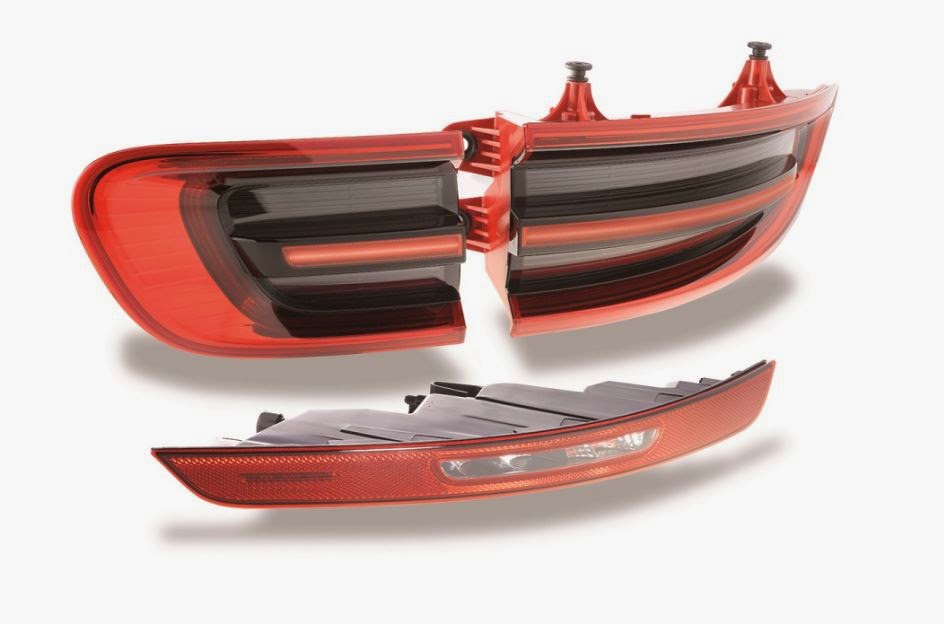CASE STUDY: Integrated LED signal lights from Hella on the Porsche Macan
- Application: Light strips for guiding LED (Porsche Macan)
- Company: Hella
- Tooling: Hofmann Innovation
- Material: PMMA
Automotive lighting is an interplay of function and design. It should be functionally outstanding and contribute to the unique look of a vehicle. For the new Porsche Macan, the company Hella developed a completely new rear lighting system with light strips for guiding LED light. The functional principle of these patented “Edgelights” for a strip-form signal light provides a new level of quality in light for the safety-related brake light function. Using this approach, the signal light can be integrated flexibly and in a space-saving manner into the outer skin of the vehicle body. An observer sees signal lights which have been smoothly integrated into the rear of the vehicle, and which give the Porsche Macan its distinctive appearance.
Completely distortion-free thick-walled PMMA body in 2K technology
The heart of the brake light is a thick-walled part made of PMMA, which is the so-called light module or light strip. This part, which has a highly complex prism geometry and reflective qualities for light guidance, was developed in partnership with Hofmann Innovation in tool making and model making. The light module also required the production team at Hella to fulfil high standards in production quality. A thick-walled PMMA body in 2K technology which is absolutely distortion-free was needed here.
Demouldability and no distortion as challenges
In order to achieve the required light values, the thick-walled PMMA part, which is made of Altuglas HT 121 or Plexiglass 8N, requires the highest standards in the 2K process for the seams. A further decisive factor is the highly complex “prism geometry” for the entry and exit of the LED light. As part of tool development, it was the task of the tool making company Siegfried Hofmann to develop a 3D contour which would allow maximum light output at the point of emission and at the same time be manageable from a production technology point of view. This applied not only to the manufacture of the series-production tools, but also to the demoulding characteristics of the light module in the tool, as well as the manageability of the process in terms of strict absence of distortion.
Further in-depth information:
1. Functional principle of the “Edgelight”
2. Ways and methods of model making
2. Ways and methods of model making
1. Functional principle of the innovative “Edgelight” light strip for LED brake lights
The basic principle of Hella’s patented light strips for a strip-form signal light (vehicle with a strip-form signal light) / DE 102011117733 A1 / http://www.google.com/patents/DE102011117733A1?cl=de) is the entry of light from a LED diode strip in a PMMA body (“Edgelight”) with deflection and exact light bundling at the exit.
The light is fed into the massive “Edgelight” (light module or light strip) from LEDs mounted on a circuit board using collimator optics. Using deflection optics within the “Edgelights”, the LED light rays are reflected into the preferred direction and then finally, using output coupling optics, emitted in the required beam direction.
The pre-conditions for such thick-walled optics made of PMMA (Altuglas HT 121 or Plexiglas 8N) are high precision optical surfaces with a very good surface quality with the lowest possible distortion in the part. The geometry of the PMMA light strip is designed in such a way that the light entering and exiting at both ends is as focussed as possible. The illumination effect of the rear lights is homogenous and bright.
2. Ways and methods of model making
There are two types of model making in product development: rapid prototyping and industrial prototyping. Rapid prototyping means: for the rear lights of the Porsche Macan, Hella needed prototypes from Robert Hofmann in order to test them and for consultation and approval from their customer Porsche. This highly dynamic consultation process required constant adaptation to design wishes and modified functional requirements. These prototype parts, which are equivalent to series-production parts, are developed using model making methods. Initially they are built as individual components, and later as rear lights built into pre-production cars.
The methods included pouring of the “Edgelight” light modules with PMMA, and CNC milling of the light entry and exit geometries in order to achieve continuous improvement of the light parameters. EMU samples were made for the complete rear light module component group, using STL technology (stereo lithography), laser sintering for plastics, aluminium processing and vaporising of the reflectors. In addition, vibration welding was used and testing materials supplied for the subsequent small batch.
With regards to small batch production, after the development and modelling phase, “Industrial Prototyping” comes into play. Porsche needs demonstration vehicles from pilot production runs for presentation at trade fairs or for dealer presentations. These vehicles correspond to production vehicles in terms of function, but some model parts are used in them. In total, Hofmann delivered 300 sets of rear lights (right and left) before start of production.
Main Picture: Caption 6: Component groups from Hofmann Innovation for the distinctive rear lighting system of the Porsche Macan






Post a Comment